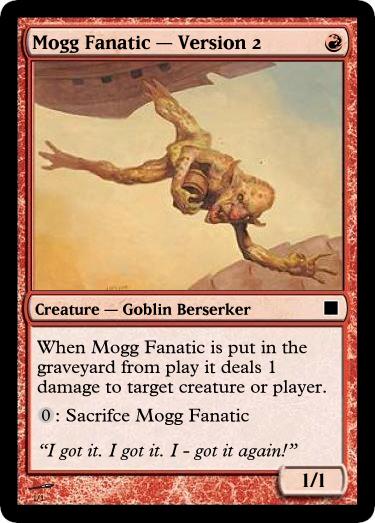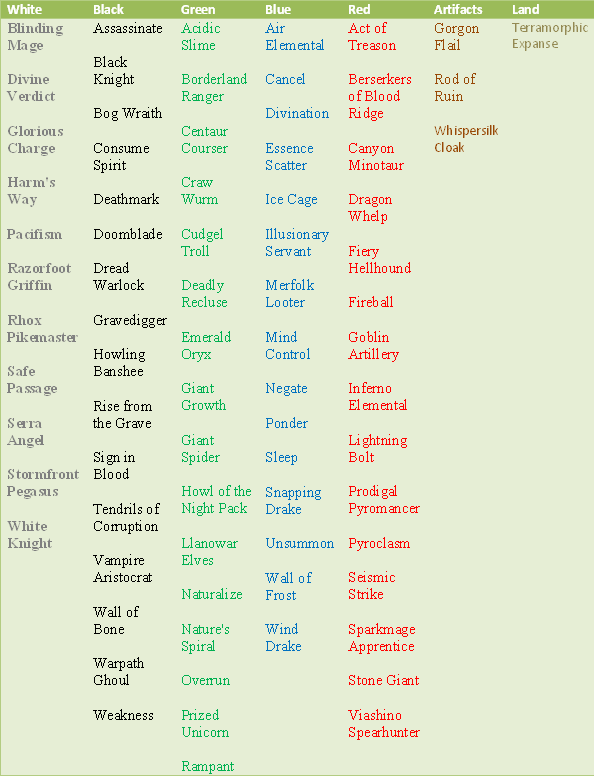Hi, welcome to my second article for MTGO Academy.
This will be a very short M10 Prerelease primer for everyone that is going to participate in the events. I have explored the format a bit and will give you a short summary of what I consider important. As soon as M10 is online I will also post some sealed and draft walkthroughs for the new set. For now I just give you a short list with nuggets of information that might help you.
First I want to talk about the new rules and the changes you should be aware of. Actually let’s only look at the most important change…
Combat damage does not use the stack
While this is already widely discussed I would encourage you to think about the impact this has on the game and the card valuations. Have a look at the following example:
Old Rules – Imagine being attacked by a Woolly Thoctar; you just blocked it with a Deadshot Minotaur and a Rhox Warmonk. So if you have a Giant Growth in your hand what would be the best play in this situation? Obviously you would have to let the damage go on stack and then after you know how the damage is dealt you would play the Giant Growth to save your creature that was dealt lethal damage.
New Rules – Your opponent attacks you with Woolly Thoctar and you want to block it with Deadshot Minotaur and Rhox Warmonk, cast the Giant Growth and save both creatures. Is that possible? Yes I will explain how. First your opponent declare attackers, then you declare both blockers. Now your opponent has to decide yet which creature will be dealt damage first and so on. The Wolly Thoctar can’t assign damage to the second creature unless it has already dealt lethal damage to the first creature your opponent decided to kill. So right after your opponent deciding the order of the creature blocks there’s another phase, where players can cast spells before damage being dealt. This is the time when you play the Giant Growth on the creature your opponent decided to deal the first damage. This way both of your creatures will survive just like they would in the old rules.
This new rule won’t change the game play that much , but some cards will become stronger and others will become respectively weaker.
Example of cards that become weaker with the new rules are Mogg Fanatic, Greater Gargadon, Sower of Tempation, Qasali Pridemage, etc… You can’t just deal damage and sacrifice creatures to remove a counter from Greater Gargadon or you can’t deal damage with your Sower of Temptation and return it to it owner’s hand killing the controller creature. Now you have to sacrifice for an effect or deal damage.
Templating will change to allow for similar effects as prior to the rule change – Magma Phoenix e.g. now triggers when it’s put in a graveyard from the game instead of sacrificing it to deal 3 damage to each creature. You can expect more cards like this. How would you love to see this card?

So even under the new rules with proper templating Wizards can still release creatures with similar effects as before.
Next I have a list of cards and abilities that will get stronger with the new set of rules. Try to figure out why those cards are better then before. It is really helpful to understand the implications of the changes if you take different combat scenarios and imagine you have this card in hand. Why is it better then before (you can of course just continue reading for the explanation…).
Lifelink
White Knight (Or any creature card with First Strike ability)
Unsummon (both stronger and weaker)
Doomblade
Goblin Artillery
Lightning Bolt
Seismic Strike
Deadly Recluse (Or any creature card with Deathtouch)
Windstorm
So why do those cards become stronger? Well the main reason is that “passive” effects such as Giant Growth or Regenerate have to be played before the damage is being assigned – so you are more likely to get a “two for one” with Doomblade or Unsummon then before.
Lifelink is now a state-based ability. This means that it will not go on the stack and resolve after you have been delt damage but rather the life is gained at the same time as damage is dealt.
First Strike creatures will make your opponents play their abilities before the “normal” damage so they are now slightly stronger then before. But the difference is not huge.
Cards that lose value are pump spells (e.g. Giant Growth), regeneration spells (e.g. Regenerate) and bounce spells (e.g. Unsummon).as they can’t be used anymore to bounce your creatures after dealing lethal damage.
Weaker, but still good.
Remember Nantuko Husk? Now it’s called Vampire Aristocrat. It’s still a good card but not as good as it used to be.
Handle with care….
Next a short list of “must plays” for sealed deck events

These are all the cards that you should play almost every time when you first look at your pool. However take mana base considerations into account. M10 has by far weaker fixing then Alara block. You wont be able to play everything unless sacrificing a great deal of consistency.
In my last artice I gave advice on how to build a sealed deck – check it out if you missed it.
Drafting M10
The best colors to draft in this core set are Black, Blue and White. Drafting some green-white aggressive decks is also ok but you should avoid drafting friendly colors for now. Why?
If you try to draft archetypes like the usual RG, WG, UB, UW, BR, you are taking a risk of being cut on both colors as they are heavily drafted and you would have to change your plans in the middle of the draft.
So the best strategy is to draft opposite colors – one of them as main color and another as splash, this will give you enough flexibility. Avoid the Blue Green archetype, it’s the weakest of all the archetypes.
Hopefully I can provide you with some draft and sealed walkthroughs soon. Until then have fun,
Paulo Carvalho

